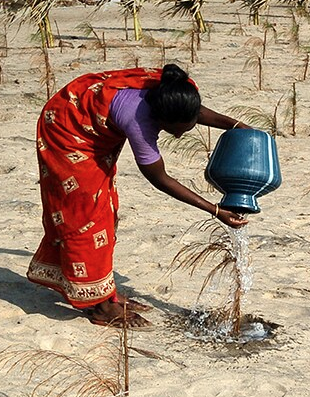Speeches Shim

Return to EnviroLinks Newsletter
Extreme weather and climate impacts can have direct and indirect effects on development projects around the world. Without proper risk assessment and management, climate variability and change can undermine the success and sustainability of such endeavors. The climate risk management (CRM) process aims to “improve the effectiveness and sustainability of USAID’s efforts, ensuring U.S. taxpayer dollars are well spent and more effectively supporting countries in their journey to self-reliance.”
With few exceptions, all strategies, projects, and activities are required to implement CRM. This involves evaluating current and future climate risks and opportunities and then incorporating adaptation measures as appropriate. For example, seasonality of mosquitos that transmit malaria could negate the effectiveness of projects combating the disease if pesticide spraying campaigns are carried out at the wrong time. However, by understanding these changes, project teams can create seasonally-informed operational plans to ensure spraying occurs in relation to the onset of the malaria season. The CRM analysis is typically included, within, or as an annex to, a Request for Categorical Exclusion (RCE), Initial Environmental Examination (IEE), or Environmental Assessment (EA).
For further guidance on the CRM process as it pertains to GH, contact the GH Climate Integration Liaison (CIL), Dennis Durbin at ddurbin@usaid.gov. Dennis is also the Bureau Environmental Officer (BEO) for GH and recently took over as the GH CIL after Ben Gustafson’s departure from USAID.
To successfully implement CRM, USAID has developed various tools and resources to assist project teams with systematically assessing, addressing, and adaptively managing climate risk in new strategies, projects, and activities. These tools also help project teams produce the documentation required by the USAID Mandatory References, Climate Change in USAID Strategies and Climate Risk Management for USAID Projects and Activities. Key tools and resources include:
- Understanding Climate Change Impacts & Opportunities (by sector, including Health): https://www.climatelinks.org/tools/climate-impacts-by-sector
- Climate Risk Screening and Management Tools: https://www.climatelinks.org/resources/climate-risk-screening-management-tool
- CRM Tool Health Annex: https://www.climatelinks.org/sites/default/files/2017-06-13%20USAID%20CRM%20Tool%20Health%20Annex.pdf
- GH CRM Annex Template (Implementing Partners may request access by sending an email to ghcompliancesupport@usaid.gov): https://sites.google.com/a/usaid.gov/ghguidance/templates
For further guidance on the CRM process as it pertains to GH, contact the GH Climate Integration Liaison (CIL), Dennis Durbin at ddurbin@usaid.gov. Dennis is also the Bureau Environmental Officer (BEO) for GH and recently took over as the GH CIL after Ben Gustafson’s departure from USAID. To submit your GH CRM Annex for review and clearance by the CIL, submit the document through the GH Environmental Compliance Document Submission Portal. Access to this Portal is only available for USAID staff. If you are an Implementing Partner, please contact your designated Activity Manager or Agreement Officer’s Representative/Contracting Officer’s Representative (AOR/COR). If you have any questions, you can also contact the GH Compliance Support Team at ghcompliancesupport@usaid.gov.

Comment
Make a general inquiry or suggest an improvement.